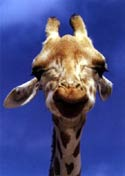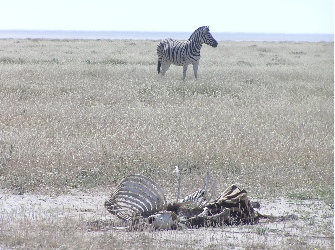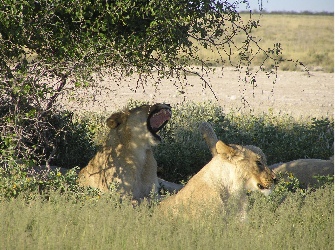 In Etosha (more)
In Etosha (more)
20th April, Ian
So, having ended my last blog by saying that
lions rarely do interesting things I have to make a qualification. Yesterday
(that would be Wednesday by my watch) we rose and went on what would be one of
our longest game drives. As we headed away from the campsite we noticed an
extraordinary number of zebra and the more we drove the more we saw. Hundreds
of them were filing along on a line parallel to and towards us; many of them
walked along the gravel road coming within a few feet of the car. The previous
evening, after our encounter with the rhino at Halali, we had visited a similar
waterhole just outside the camp fence with a viewing point just inside at our
present camp. There had been no rhino this time but a herd of zebra. Under the
moonlight they were for some while all eerily still, apparently asleep on their
feet. Then one of them must have got spooked and they all stamped around
together. In the still of night, the clattering of hooves added to the strange
oneiric quality of the scene. (Film buffs can compare it to the backdrop sound
of horses running that pervades Lancelot du Lac - very similar.) Anyway, this
dreamlike experience of zebra from the previous evening no doubt charged our
perception of them early the following morning. As we eventually came to the
end of the procession of zebra we saw something else on the road ahead: a pride
of lions walking behind them. The lions were recognisable as soon as they came
into view from their menacing power-shoulder walk. There were six of them, all
walking either on or just to the side of the road; one or two were juvenile
males and the remainder were females. We were already travelling very slowly to
avoid the zebra and we stopped completely and let the lions pass, resisting the
unnecessary temptation to wind up our windows. After they passed we turned the
car and crept along with them. At times the lions broke into a run. As they
neared the zebra the zebra, rather than trying to flee, stood stock still.
After a while we came to a small pool of water gathered by the roadside. One or two of the lions started to drink from it and then they jostled for space on a small rock from which they could drink without muddying their paws. (I may post a movie clip of this on a separate blog to avoid jamming up anyone's web link.)
Being daylight, we didn't expect the lions to attack - but you never know, they look so ominous. The essential relationship between lions and zebra can be characterised with a couple of snaps, the first being of what in the workplace might be described as zebra who have just experienced a "reduction in force":

The next was taken later yesterday. When we returned past the same spot towards the end of our morning game drive the lions had set themselves down under an acacia near the pool where they had been drinking. On our evening game drive we passed the same tree and they were still there:

Not being experts, we can only speculate about the relationship between the zebras' march and the lions'. Our best guess is that the zebra were moving for their own reasons and that the lions were not so much stalking them for a kill as keeping in touch with a food source on the move. After leaving the lions the first time we came upon hundreds more zebra in this region of Etosha who also seemed to be moving en masse. Surprisingly, on the two times that we returned to the lions under the acacia we saw groups of zebra curiously daring each other closer to them, probably sensing that the lions, who, incidentally, looked much better fed than those we saw in Moremi, were unlikely to strike. But what is the evolutionary advantage for zebras in playing chicken (sorry) with lions?
Time, perhaps, to say a little more about the National Park. I don't know if it's come out from the previous entry but there are three campsites in Etosha. The first one that we stayed at, which is at the eastern of the park, is called Namutoni and is centred around an old German fort. Namibia, if I haven't said it already, is a former German colony and has evidently retained some sort of relationship of affinity with Germany, judging from the number of Germans we've met here. Nonetheless, the common language is English. The second site we stayed at, where we saw the rhino, was Halali, and the third, where I am now, Okaukuejo. Okaukeujo is actually the oldest of the three, but if I'd guessed I would have said it was the newest. To me it seems the most modern and comfortable, and is almost turning into a pastiche of the campsite-in-the-park genre. Half Africa, half Maui, in the sense that I mentioned before. This is evident in many ways, from the iconic Lawrence of Arabia crenelated tower in the middle of the site (actually built in 1963) to the experience at the campsite restaurant (we had our one and only visit last night, and preferred the food we'd cooked ourselves). Even so, if you were coming to one of these places for a week or two, you could do worse than renting one of the quaint thatched roundels here at Okaukuejo.
The western end of Etosha is not accessible to independent travellers, the Namibian government apparently assessing that they can generate more wealth by reserving some privileges for the tour operators. They are probably right and I wish them well. Most of the staff around here wear epaulettes for the Ministry of Environment and Tourism. This conjunction of responsibilities seems fruitful. (Has Bush created a Ministry of Environment and Oil Drilling yet?)
The vegetation at the park is varied. Etosha is developed around the southern edge of a huge flat arid pan. There are swathes of grassland, areas of vegetation where low trees (often Mopane or Acacia) dominate, more closely forested areas, and huge sandy stretches. Individually, these environments can seem severe; sometimes you come across mixed areas that seem composed and are more classically beautiful. The same is true of the animals: often they are seen in large uniform herds, but occasionally you will see groups of them together, say at a waterhole, forming the sort of tableau that people paint.
One notable feature of entering the national parks is that it dramatically reduces the odds of meeting local Africans other than those that work in some sort of service function. I don't have the sense that I had in Zambia that the more I hung around the more interesting locals I would meet. We have run into a few people from Germany, South Africa and even England who have all been very nice, and would have been interesting to talk to some more; but this is one of the few legs on our trip when we are moving about a lot and developing friendships is less easy. I hope that the people of Namibia and Botswana, who are collectively accruing sensible economic benefit from the parks, get to see all of their animals that they want to.
On a final note for today, I finished Waiting for the Barbarians yesterday. A bleak book and very atmospheric, and obliquely but satisfyingly appropriate for this part of our trip. I read it as we sat by the pool - all of the camps have pools, which we all enjoy.
After a while we came to a small pool of water gathered by the roadside. One or two of the lions started to drink from it and then they jostled for space on a small rock from which they could drink without muddying their paws. (I may post a movie clip of this on a separate blog to avoid jamming up anyone's web link.)
Being daylight, we didn't expect the lions to attack - but you never know, they look so ominous. The essential relationship between lions and zebra can be characterised with a couple of snaps, the first being of what in the workplace might be described as zebra who have just experienced a "reduction in force":

The next was taken later yesterday. When we returned past the same spot towards the end of our morning game drive the lions had set themselves down under an acacia near the pool where they had been drinking. On our evening game drive we passed the same tree and they were still there:

Not being experts, we can only speculate about the relationship between the zebras' march and the lions'. Our best guess is that the zebra were moving for their own reasons and that the lions were not so much stalking them for a kill as keeping in touch with a food source on the move. After leaving the lions the first time we came upon hundreds more zebra in this region of Etosha who also seemed to be moving en masse. Surprisingly, on the two times that we returned to the lions under the acacia we saw groups of zebra curiously daring each other closer to them, probably sensing that the lions, who, incidentally, looked much better fed than those we saw in Moremi, were unlikely to strike. But what is the evolutionary advantage for zebras in playing chicken (sorry) with lions?
Time, perhaps, to say a little more about the National Park. I don't know if it's come out from the previous entry but there are three campsites in Etosha. The first one that we stayed at, which is at the eastern of the park, is called Namutoni and is centred around an old German fort. Namibia, if I haven't said it already, is a former German colony and has evidently retained some sort of relationship of affinity with Germany, judging from the number of Germans we've met here. Nonetheless, the common language is English. The second site we stayed at, where we saw the rhino, was Halali, and the third, where I am now, Okaukuejo. Okaukeujo is actually the oldest of the three, but if I'd guessed I would have said it was the newest. To me it seems the most modern and comfortable, and is almost turning into a pastiche of the campsite-in-the-park genre. Half Africa, half Maui, in the sense that I mentioned before. This is evident in many ways, from the iconic Lawrence of Arabia crenelated tower in the middle of the site (actually built in 1963) to the experience at the campsite restaurant (we had our one and only visit last night, and preferred the food we'd cooked ourselves). Even so, if you were coming to one of these places for a week or two, you could do worse than renting one of the quaint thatched roundels here at Okaukuejo.
The western end of Etosha is not accessible to independent travellers, the Namibian government apparently assessing that they can generate more wealth by reserving some privileges for the tour operators. They are probably right and I wish them well. Most of the staff around here wear epaulettes for the Ministry of Environment and Tourism. This conjunction of responsibilities seems fruitful. (Has Bush created a Ministry of Environment and Oil Drilling yet?)
The vegetation at the park is varied. Etosha is developed around the southern edge of a huge flat arid pan. There are swathes of grassland, areas of vegetation where low trees (often Mopane or Acacia) dominate, more closely forested areas, and huge sandy stretches. Individually, these environments can seem severe; sometimes you come across mixed areas that seem composed and are more classically beautiful. The same is true of the animals: often they are seen in large uniform herds, but occasionally you will see groups of them together, say at a waterhole, forming the sort of tableau that people paint.
One notable feature of entering the national parks is that it dramatically reduces the odds of meeting local Africans other than those that work in some sort of service function. I don't have the sense that I had in Zambia that the more I hung around the more interesting locals I would meet. We have run into a few people from Germany, South Africa and even England who have all been very nice, and would have been interesting to talk to some more; but this is one of the few legs on our trip when we are moving about a lot and developing friendships is less easy. I hope that the people of Namibia and Botswana, who are collectively accruing sensible economic benefit from the parks, get to see all of their animals that they want to.
On a final note for today, I finished Waiting for the Barbarians yesterday. A bleak book and very atmospheric, and obliquely but satisfyingly appropriate for this part of our trip. I read it as we sat by the pool - all of the camps have pools, which we all enjoy.
Posted: Thu - April 21, 2005 at 12:35 PM
Quick Links
Links
Archives
XML/RSS Feed
Calendar
| Sun | Mon | Tue | Wed | Thu | Fri | Sat |
Categories
Comments powered by
Statistics
Total entries in this blog:
Total entries in this category:
Published On: Feb 08, 2006 06:20 PM
Total entries in this category:
Published On: Feb 08, 2006 06:20 PM